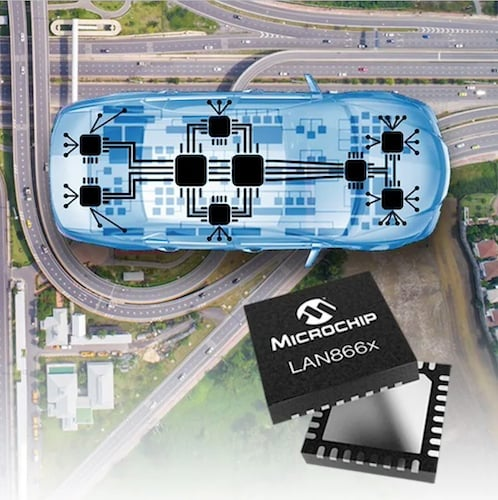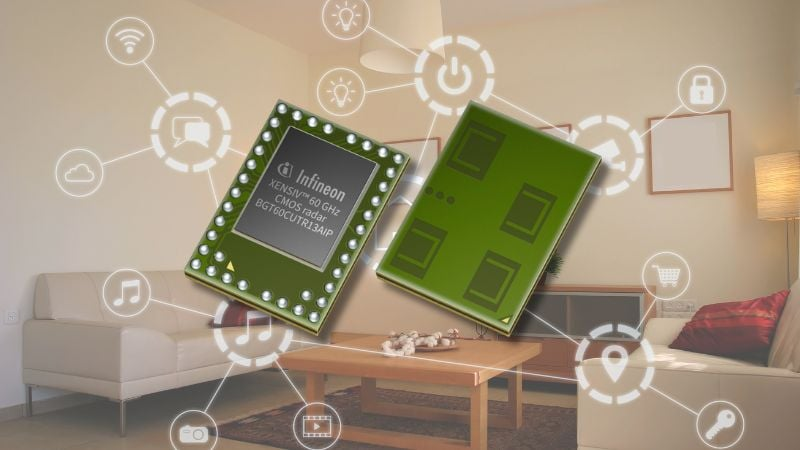The LAN866x family integrates the Remote Control Protocol to eliminate edge node software and accelerate zonal Ethernet deployment.
Microchip recently introduced its LAN866x series of 10BASE-T1S Ethernet endpoint devices. Built for in-vehicle networking applications, these ICs employ the Remote Control Protocol (RCP) to eliminate software on edge nodes and facilitate true centralized control of systems.

Microchip’s LAN866x family.
According to Microchip, the LAN866x endpoints allow Ethernet to extend to the network edge and reduce development time, hardware costs, and system complexity.
LAN866x Family
The flagship of Microchip’s announcement is the LAN866x endpoint IC family, which includes dedicated variants for control (LAN8660), lighting (LAN8661), and audio (LAN8662) applications. An important feature of these devices is that they translate Ethernet packets directly to local digital interfaces using an OA3p network interface. In that way, the chips remove the need for microcontroller-based logic or embedded code at each node.
These software-less endpoints function in conjunction with a centralized Ethernet controller, which manages node behavior via RCP commands. With this configuration, OEMs can develop a single software stack at the central node, which simplifies compliance, testing, and maintenance.
Microchip’s solution also reduces silicon area and power consumption at the node level by removing unnecessary compute elements. According to the company, this architecture is particularly well-suited for zonal networks that focus on consolidating ECU functionality. By utilizing a 10BASE-T1S multidrop topology, the LAN866x family supports a shared single-pair Ethernet. As a result, designers can operate multiple endpoints concurrently on the same twisted pair without switching overhead or star topology wiring.
Each device operates over an extended automotive temperature range of -40°C to +125°C and is available in a 32-VQFN package. Applications include direct Ethernet bridging to LED drivers for lighting control, audio transport to microphones and speakers, and bidirectional communication with distributed actuators and sensors.
RCP and 10BASE-T1S in Zonal Architectures
Zonal automotive architectures depend on efficient communication between the central compute unit and the distributed sensors and actuators dispersed throughout the vehicle. Remote Control Protocol offers a solution by standardizing how the central processors interact with endpoint peripherals over Ethernet.

Single-pair Ethernet implementations.
In a typical RCP-based system, the central controller issues commands over the Ethernet network, and the endpoint ICs transparently bridge the physical hardware interfaces. This contrasts with traditional automotive networking protocols like CAN or LIN, where each node interprets and processes bus messages locally. RCP simplifies the process by offloading all logic to the core software stack to improve software reuse and debugging efficiency.
10BASE-T1S is particularly well-suited for RCP due to its multidrop topology and low signaling complexity. While 100BASE-T1 or higher-speed variants typically require point-to-point links and PHY negotiation, 10BASE-T1S allows multiple devices to connect over a single pair of wires. The IEEE 802.3cg standard specifies operation at 10 Mbps with deterministic, full-duplex communication and minimal latency. Such features make the standard appropriate for control and sensor networks in zonal architectures.
By combining 10BASE-T1S with RCP, system designers can dramatically reduce the number of ECUs in a vehicle, lower the cost per node, and centralize diagnostics and updates.
Centralization Over Distribution
Microchip hopes that the LAN866x family will influence the way designers apply Ethernet in automotive networks. By removing the need for per-node software and enabling remote control via standard protocols, these endpoint ICs offer a compelling pathway to fully centralized zonal architectures. The family is currently available in limited sampling.
All images used courtesy of Microchip.


